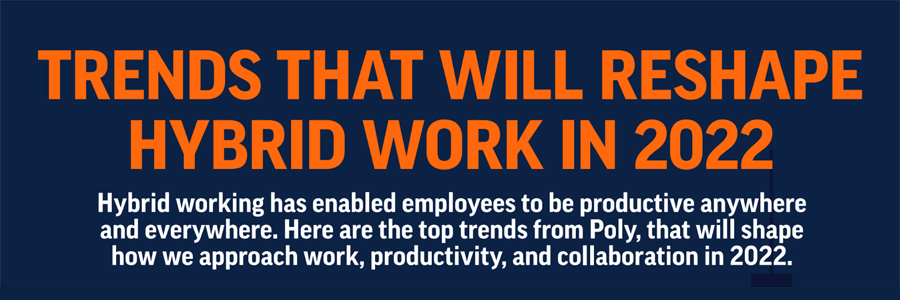#1: Productivity Anywhere Will Shake Up Workforce and Workplace Structure
Remote working has enabled employees to be productive anywhere, everywhere, and anytime. With hybrid working being the default arrangement, business leaders will start looking into providing a more equitable work experience for those inside and outside the office, especially during meetings and group discussions. Willis Tower Watson’s recent 2021 Employee Experience survey found that 90% of APAC employers are prioritizing enhancing the employee experience over the next three years
This collaborative infrastructure will also complement the greater adoption of asynchronous work practices – a trend triggered by the pandemic. It will not just redefine how employees collaborate with one another, but also help businesses rethink hiring practices and tap into a more global and diversified talent pool. Industries have and will continue to change how they work, with decentralised work practices and processes enabling effective business continuity for a workforce that may be largely working from home.
#2: Greater Use of A.I. and Data Analytics in the Workplace
According to a survey by Juniper Networks, 95% of respondents said their companies’ daily operations, products and services would benefit from implementing AI technologies. Leaders across the region will start adopting AI and data analytics to support and improve employee productivity and safety, in addition to driving business growth and operational efficiency, as part of their continued digital transformation plan.
IT departments will turn to data and insights to have a more objective view on employee productivity both in the office and when they work remotely. These will help inform decisions on what technology investments to help a hybrid workforce collaborate better. Office managers will also leverage insights such as occupancy data can help office managers determine the most effective office layout, minimise wasted space and reinforce or improve proper safe distancing measures.
#3: Office Spaces Reimagined for a Hybrid Future
With employees working remotely half or most of the time, companies are turning to a flexible and cost-effective approach for their office space investment. In Singapore, central business district (CBD) office occupiers could aim to reduce their footprint by 10% to 20% over the next three years, according to Maybank Kim Eng.
There will be a growing adoption of the office on-demand approach to help businesses effectively add on workspaces as needed. On the other hand, companies with existing excess office space can consider subleasing part of that space as needed; this ‘core and flex’ model enables a combination of long-term security for core operations while allowing flexibility for growth. At the same time, companies will start redefining workforce roles and determine which functions are best suited to be based in central business district (CBD) areas, and who can work either remotely or in satellite offices in regional cities or districts.
Business leaders will also look how to make return to office something that employees look forward to. Offices will become collaboration hubs, serving as a place for teams to gather to brainstorm in small groups, host client meetings, celebrate milestones, and work on joint projects. They will also serve as a central hub for community socialisation that will help provide a culture that cannot be replicated via remote working.
Looking Ahead: Organisations Must Invest in Technology that Improve Employee Experiences
Companies’ technology investments and collaboration strategies will focus on improving employees’ working experience both remotely and on-site. Users are expecting technology to be easy to use to minimise disruption that may hamper productivity and collaboration, so that they can spend more time getting real work done instead of figuring out how the tools work.
With limitations around business travels and in-person meetings, video conferencing is now the norm for collaboration. This also led to new usage model of videos such as telemedicine, hybrid events, virtual property viewing and educational courses via videos. As such, more and more organisations are adopting a no-compromise attitude to ensure the highest quality video solutions are used for high level productivity, resilience, and customer experience.
This will drive an increased demand in pro-grade technology and collaboration tools that are geared to drive better user experiences. ReportLinker is already forecasting that the Asia Pacific Video Conferencing Market will grow at a CAGR of 17.8% within 2021-2027.This is prime opportunity for collaboration vendors that are platform-agnostic to thrive, as they enable office collaborators to use the same infrastructure in the conference room as they have grown accustomed to using from their home offices.
Liked this post? Follow SwirlingOverCoffee on Facebook, YouTube, and Instagram.


